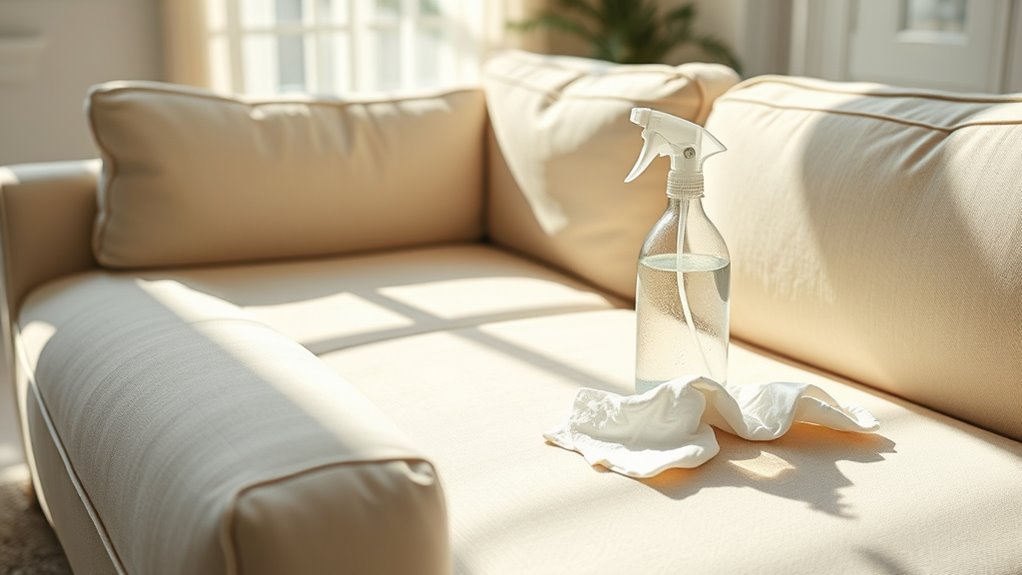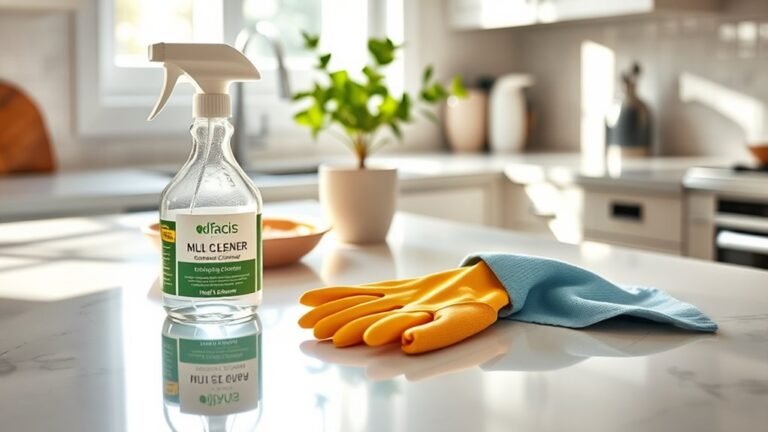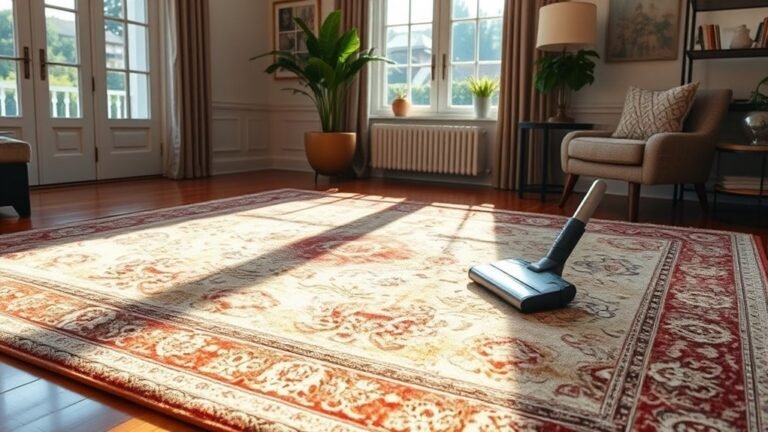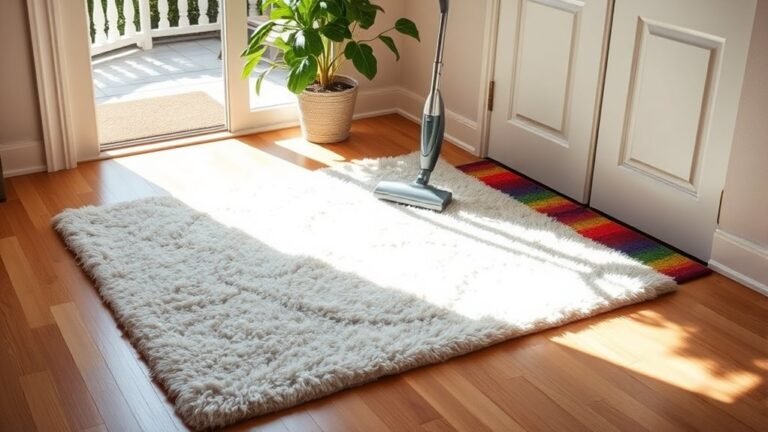Disinfecting High-Touch Areas in Sofa
To disinfect high-touch areas on your sofa, focus on armrests, seat cushions, and buttons where germs gather most. Start by vacuuming debris with a brush attachment, then use a fabric-safe disinfectant to lightly mist these spots. Wipe gently without soaking the fabric, and let it air dry completely. Avoid harsh chemicals to keep your sofa looking fresh and undamaged. Stick with these simple steps to keep germs at bay—and discover more ways to maintain a cleaner, healthier sofa.
Identifying High-Touch Areas on Your Sofa

Before you start disinfecting, it’s important to recognize which parts of your sofa get touched the most. Developing touchpoint awareness helps you focus your efforts where they matter, ensuring better sofa hygiene without wasting time. Think about where your hands rest—armrests, seat cushions, and the backrest are prime spots. If you often eat or work on your sofa, areas like the middle cushion or nearby surfaces might see extra contact. Don’t forget about the sofa’s edges and buttons, which attract frequent touches too. By identifying these high-touch zones, you gain control over your cleaning routine, making it more efficient and freeing you from unnecessary hassle. This targeted approach empowers you to keep your living space cleaner and healthier with minimal effort.
Choosing the Right Disinfectants for Sofa Materials
When picking disinfectants for your sofa, it’s important to choose ones that are safe for the specific material to prevent damage. You’ll want to avoid harsh chemicals that can discolor or weaken the fabric. At the same time, make sure the product has effective antimicrobial properties to properly kill germs on those high-touch spots.
Material-Safe Disinfectants
Although you want your sofa to stay clean and germ-free, choosing the wrong disinfectant can damage its material. To keep your sofa safe and fresh, look for material-safe disinfectants that won’t compromise its texture or color. Natural disinfectant alternatives like vinegar and tea tree oil offer effective, gentle cleaning without harsh chemicals. If you prefer ready-made products, seek out eco friendly options labeled safe for upholstery—these are designed to protect both your furniture and the environment. Always test a small, hidden area first to avoid surprises. By selecting disinfectants thoughtfully, you maintain your sofa’s life and your freedom to relax worry-free, knowing your high-touch areas stay hygienic without sacrificing material quality.
Avoiding Fabric Damage
Since your sofa is made from delicate materials, choosing the right disinfectant is essential to avoid damage. You want to maintain fabric care while ensuring effective stain prevention. Harsh chemicals can degrade fibers or cause discoloration, so pick gentle, fabric-safe solutions. Test any product on a hidden spot first to keep freedom from unwanted marks.
| Fabric Type | Recommended Disinfectant |
|---|---|
| Cotton | Mild detergent + water |
| Microfiber | Alcohol-based spray (diluted) |
| Leather | Specialized leather cleaner |
| Velvet | Vinegar-water solution (diluted) |
Effective Antimicrobial Agents
To keep your sofa both clean and safe, you’ll want to choose disinfectants that effectively eliminate germs without harming the fabric. Look for agents with proven antimicrobial efficacy against bacteria, viruses, and fungi commonly found on high-touch surfaces. Quaternary ammonium compounds and hydrogen peroxide-based solutions often provide strong germ-killing power while being gentle on materials. Avoid bleach or harsh chemicals that can degrade fibers and reduce surface longevity. Always test a small, hidden area first to verify no discoloration or damage occurs. By selecting disinfectants that balance powerful antimicrobial action with fabric care, you maintain your sofa’s cleanliness and extend its life—giving you the freedom to relax without worry. Your choice matters; pick products that protect both your health and your investment.
Preparing Your Sofa for Disinfection
Before you start disinfecting, make certain to clear any surface debris from your sofa to allow better contact with cleaning agents. Next, pinpoint the high-touch zones like armrests, cushions, and buttons where germs tend to accumulate. This prep work helps guarantee your disinfection is both thorough and effective.
Clear Surface Debris
Start by removing any visible debris from your sofa’s surface to make certain the disinfectant can work effectively. Grab a vacuum with a brush attachment or a soft cloth to clear crumbs, dust, and pet hair. This simple step makes certain your disinfectant reaches the fabric or leather directly, avoiding a barrier that reduces its power. Practicing regular sofa cleaning not only looks great but also boosts your home’s hygiene practices, giving you peace of mind. Don’t rush—take your time to cover every corner, including crevices where dirt loves to hide. By clearing surface debris thoroughly, you set the stage for a deep, effective disinfection that keeps your space fresh and safe while maintaining your freedom to relax without worry.
Identify High-Touch Zones
Several key areas on your sofa get touched more often than others, making them prime spots for germs and bacteria to accumulate. To maintain excellent sofa hygiene, you need to identify these high-touch zones and prioritize them during your cleaning routine. Paying attention to these areas will help you determine the ideal cleaning frequency and keep your space fresh and safe, giving you the freedom to relax worry-free.
| High-Touch Zones | Reason for Focus |
|---|---|
| Armrests | Frequent hand and arm contact |
| Seat cushions | Direct body contact |
| Sofa edges and seams | Collects dirt, sweat, and oils |
Focus on these key spots to enhance your sofa hygiene and enjoy a cleaner, healthier living environment.
Step-by-Step Guide to Disinfecting Fabric Sofas

When you’re ready to disinfect your fabric sofa, it’s important to gather all necessary supplies, including a vacuum, fabric-safe disinfectant, and clean cloths. Proper sofa maintenance means sticking to a regular cleaning frequency to keep germs at bay and your space fresh.
Follow these steps for freedom from worry:
- Vacuum thoroughly, focusing on cushions and crevices.
- Lightly mist fabric-safe disinfectant on high-touch areas.
- Gently wipe with a clean cloth, avoiding saturation.
- Allow the sofa to air dry completely before use.
Disinfecting Leather and Faux Leather Sofas Safely
Although leather and faux leather sofas are easier to wipe down than fabric, you’ll still want to use gentle, non-abrasive disinfectants to avoid damaging their surface. When disinfecting, opt for products specifically designed for leather care or a mild solution of water and gentle soap. Avoid harsh chemicals that can strip natural oils or cause cracking. For faux leather, a diluted mixture of rubbing alcohol and water works well without compromising the material’s finish. Always test any cleaner on a hidden spot first to verify it doesn’t discolor or degrade the sofa. After disinfecting, wipe the surface dry with a soft cloth to prevent moisture buildup. By following these steps, you can keep your leather and faux leather sofas fresh and germ-free while preserving their look and feel.
Tips for Maintaining a Germ-Free Sofa Between Deep Cleans

Keeping your sofa germ-free between deep cleans doesn’t have to be complicated. With smart sofa maintenance, you can enjoy a fresh, hygienic space without feeling tied down by constant scrubbing. Focus on simple, effective habits to guarantee germ prevention stays effortless.
Smart sofa care means a fresh, germ-free space without constant scrubbing or hassle.
- Use removable, washable covers on cushions to catch dirt and bacteria.
- Wipe down high-touch areas like armrests and headrests with disinfectant wipes regularly.
- Encourage family and guests to wash hands before sitting to reduce germ transfer.
- Keep pets off the sofa or clean their paws before they hop on.
Preventing Germ Build-Up With Regular Cleaning Habits
Regular cleaning habits are key to stopping germs from piling up on your sofa. By sticking to a simple routine, you take control of germ prevention, freeing yourself from worry about hidden bacteria. Make it a habit to wipe down high-touch areas like armrests and cushions with disinfectant wipes every few days. Vacuuming regularly removes dirt and microbes lurking in fabric fibers. These regular habits don’t just keep your sofa fresh—they create a healthier space for you to relax without restrictions. Embracing consistent cleaning helps you maintain your freedom to enjoy your home confidently, knowing germs aren’t gaining ground. Remember, small daily efforts in germ prevention add up, making deep cleans easier and your sofa a safer spot for everyone.
Frequently Asked Questions
Can Disinfectants Damage Sofa Cushions or Springs?
Ever worried that using disinfectants might ruin your sofa’s comfort? You’ve got to pick the right disinfectant types to keep your cushions safe. Some harsh chemicals can damage delicate cushion materials or even affect the springs inside. Would you want to lose the freedom to lounge comfortably? Opt for gentle, fabric-safe disinfectants and always test a small spot first. That way, you protect your sofa and keep your relaxation zone just right.
How Often Should Professional Sofa Cleaning Be Done?
You’ll want to follow frequency guidelines that suggest professional sofa cleaning every 12 to 18 months. This timing strikes a balance between maintaining your sofa’s appearance and avoiding unnecessary wear. Regular cleaning brings benefits like removing allergens and prolonging fabric life, giving you the freedom to relax without worries. Of course, if you have pets or allergies, you might want to schedule cleanings more often to keep your space fresh.
Are UV Light Sanitizers Effective for Sofas?
You might be curious about UV effectiveness for sanitizing sofas. UV light can kill bacteria and viruses, making it a handy option if you’re aiming for a cleaner space. However, you should always follow safety precautions since UV rays can harm your skin and eyes. So, while UV sanitizers can boost hygiene, don’t rely solely on them—combine with regular cleaning for the best freedom from germs.
Can Pets Affect the Disinfection Process?
You might think pets don’t really impact disinfection, but pet fur can actually carry bacteria, increasing bacterial transfer on surfaces. So, when you disinfect, you’re not just cleaning the sofa—you’re battling the unseen trail your furry friend leaves behind. To keep your space truly fresh, you’ll want to regularly clean pet fur off high-touch areas. That way, you stay in control and keep germs at bay without sacrificing your pet’s freedom.
What Are Safe Disinfectants for Antique or Delicate Sofas?
When caring for antique or delicate sofas, you’ll want to choose fabric safe cleaners that won’t harm the material. Natural disinfectants like diluted white vinegar or hydrogen peroxide are great options—they’re gentle yet effective. Avoid harsh chemicals that strip color or damage fibers. You deserve to keep your treasured pieces fresh without restrictions, so opting for these safer, natural solutions gives you freedom to maintain both cleanliness and integrity.






